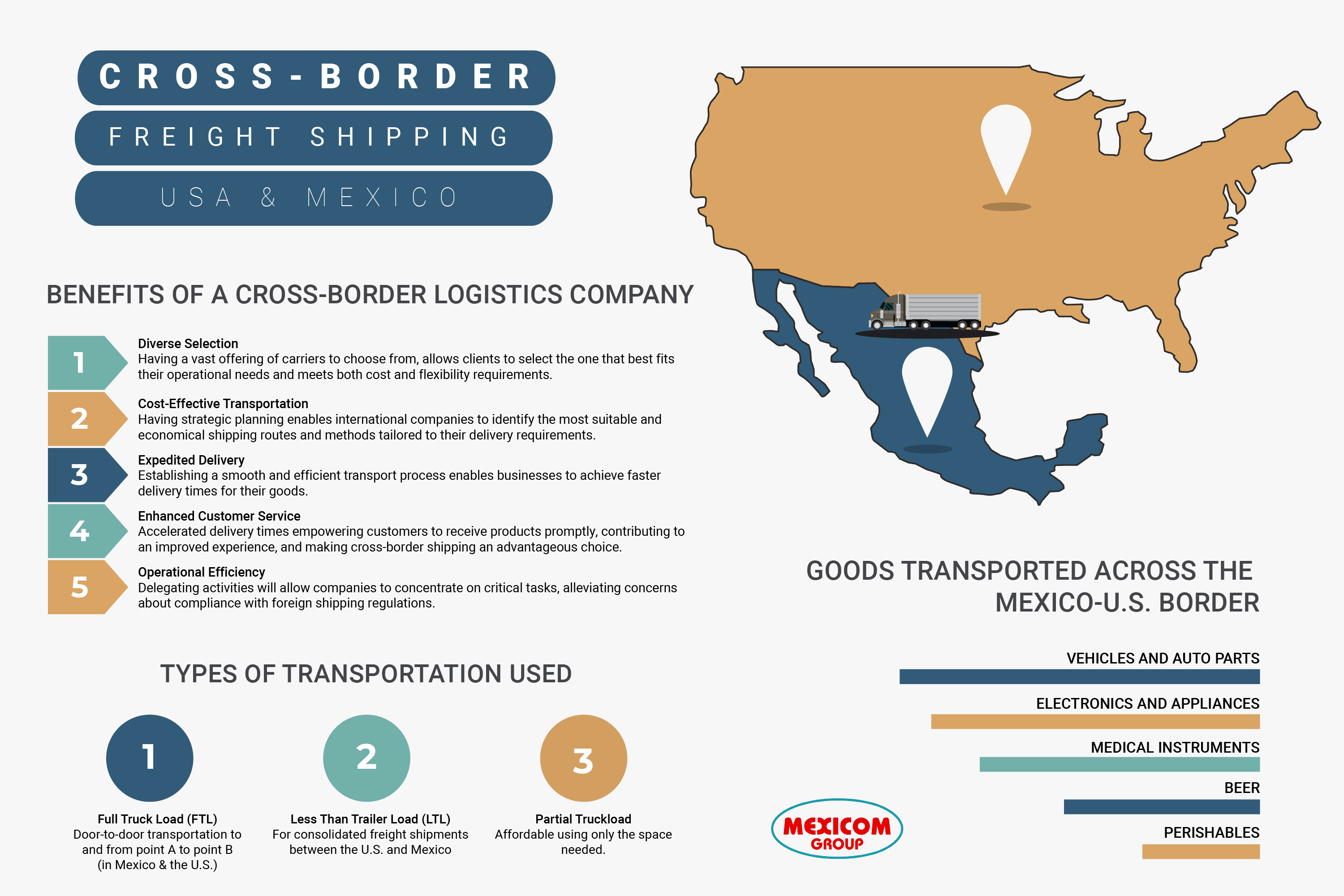Door-to-Door Cross-Border Freight Shipping through U.S. & Mexico
The cross-border shipping through the United States and Mexico requires a thorough understanding of the unique regulations governing the movement of goods between these two trading nations. This process involves handling documentation, customs procedures, and transportation logistics to facilitate seamless transportation of commercial goods across borders. Businesses strive to prevent potential delays and penalties for non-compliance with import/export regulations and trade agreements. Positioned as the United States’ second-largest trading partner, Mexico plays a pivotal role in the cross-border movement of components, materials, and finished products. The proper management of cross-border logistics not only impacts the success of the North American supply chain but also holds the potential to enhance or hinder the efficiency and effectiveness of the supply chain between these two countries.
What Defines Cross-Border Shipment?
A cross-border shipment entails the movement of goods between two nations.
The trading countries, in this case, the United States and Mexico have distinct sets of rules and regulations. A key aspect of ensuring success in this process is gaining a comprehensive understanding of the unique regulations and cultural nuances in each location.
This encompasses the handling of documentation, customs processes, and transportation logistics of the products being shipped. The objective is to facilitate the seamless transportation of commercial goods across borders without any disruptions. While at the same trying to prevent potential delays or penalties for not adhering to import and export regulations, and trade agreements.
Making cross-border shipping is vital for businesses that are part of the movement of goods across national borders, especially those located in Mexico and the U.S. The Secretary of Foreign Relations of Mexico stated that Mexico was the United States 2nd largest trading partner at the end of 2022. Numerous enterprises in both countries depend on cross-border shipments to procure components, materials, and finished products from suppliers outside their country.
The proper management of cross-border logistics has a significant impact on the success of the North American supply chain. On the other hand, if mishandled, this process can suffer from detrimental effects on the efficiency and effectiveness of the supply chain between countries.
Benefits of Utilizing a Cross-Border Logistics Company
- Diverse Selection: Having a vast offering of carriers to choose from, allows clients to select the one that best fits their operational needs and meets both cost and flexibility requirements.
- Cost-effective transportation: Having strategic planning enables international companies to identify the most suitable and economical shipping routes and methods tailored to their delivery requirements.
- Expedited delivery: Establishing a smooth and efficient transport process enables businesses to achieve faster delivery times for their goods.
- Enhanced customer service: Working with a group of experts in cross-border shipping will result in better outcomes, like accelerated delivery times empowering customers to receive products promptly, contributing to an improved experience, and making cross-border shipping an advantageous choice.
- Operational efficiency: For an end-user company whose main line of work is not transportation and logistics, delegating these activities and processes will allow companies to concentrate on more critical tasks, alleviating concerns about compliance with foreign shipping regulations.
How Does Door-to-Door Freight Shipping Happen Between the United States and Mexico?
A large network of contacts facilitates the connection with trustworthy carriers providing high-quality services tailored to the customer’s transportation requirements. This includes considerations for the appropriate type of truck, delivery times, and pricing. Ensuring the deliveries from the precise point of pick-up in Mexico or the U.S. to the exact destination in the opposing country. Most often preferential rates for freight shipping services between the U.S. and Mexico are established with a specialized freight forwarder focused on the North American region.
Ground shipping is the optimal choice for transporting commercial goods between Mexico and the United States, given their geographical proximity and the fact that these nations share the busiest border. According to The Secretary of Foreign Relations of Mexico, both countries share a 2,000-mile border with 55 active land ports of entry. Over 1.2 million dollars in products move across the border every minute, making it the busiest in the world. Choosing a ground shipping service for transporting commercial goods between these countries is particularly an advantageous option when seeking flexible delivery times and competitive rates. Here’s a guide to know how to ship freight across the Mexico-U.S.
Types of transportation that can be used:
Full Truck Load (FTL)
Door-to-door transportation to and from point A to point B (in Mexico & the U.S.)
Ground transportation service that allocates an entire truck for a single load. This option is ideal for large loads that can fill an entire truck and is the preferred choice for transporting delicate items or goods requiring regulated temperatures. Notably, FTL stands out as the fastest among various ground transportation alternatives, as the dedicated truck for a single load eliminates the need for scales, ensuring a more efficient transit time. Moreover, the FTL service enhances security by minimizing cargo handling to only two instances – during pickup and at the final destination – thereby reducing the risk of potential damage. This makes FTL an excellent choice for transporting sensitive or fragile loads.
Less Than Trailer Load (LTL)
For consolidated freight shipments between the U.S. and Mexico
It involves consolidating freight from multiple customers into a single truck. Essentially, this means that the truck’s unused space from customers whose shipments don’t require a full trailer is utilized to accommodate another customer’s shipment. The cost for each customer is determined based on various factors such as the type (class), quantity, weight, size, and density of the shipment, as well as the distance it needs to travel. This approach optimizes transportation efficiency by efficiently utilizing available space and distributing costs according to individual shipment characteristics and distance traveled.
Partial Truckload
Affordable using only the space needed
Optimal and cost-effective transportation solution designed for larger loads that do not necessitate utilizing the entirety of available space on a full trailer. It proves to be more economical than Full Truckload freight service since customers are not charged for a dedicated trailer. Within the partial truckload mode, customers can efficiently transport larger loads than typically accommodated by Less Than Truckload services.
For partial truckload freight, specific weight and size apply. The load should exceed 12 linear feet (equivalent to 6 standard-size pallets) but remain below 30 linear feet. The total weight must fall between a minimum of 1,000 pounds and a maximum of 25,000 pounds, with an individual pallet not surpassing 5,500 pounds.
Choosing the partial truckload mode, whether for the entire route or part of an international transport journey, presents a substantial advantage in terms of cost savings, potentially reducing transportation expenses by up to 50% compared to the Full Truckload mode, particularly when the load occupies a space between 12-30 linear feet.
Cross-border door-to-door freight transportation to the main cities and states:
In Mexico
- Mexico City
- Aguascalientes
- Queretaro
- Puebla
- Tlaxcala
- Guadalajara
- Monterrey
- Saltillo
- San Luis Potosi
In the U.S. East Coast
- Maine
- Vermont
- New Hampshire
- Massachusetts
- New York
- New Jersey
- Pennsylvania
- Connecticut
- North Carolina
- South Carolina
- Georgia
- Florida
In the U.S. Midwest
- Michigan
- Ohio
- Indiana
- Kentucky
- Illinois
In the U.S. South (cities)
- Houston
- Dallas
- Laredo
In the U.S West (cities)
- Los Angeles
- San Francisco
What types of goods are being transported across the Mexico-U.S. border?
The border between the United States and Mexico holds the distinction of being the world’s busiest. According to the U.S. government in the current market, Mexico exports approximately $400 billion worth of merchandise to the United States on an annual basis. The Mexico-U.S. border witnesses 4.3 million truck crossings annually. Bilateral trade has nearly tripled, with cross-border transactions averaging over $650 million per day, and the majority—two-thirds—flowing through entry ports in Texas.
These are the goods that have the most significant impact on the Mexico-U.S. border:
1. Vehicles and Auto Parts
Mexico manufactures 16 out of every 100 cars sold in the United States and since 2019, Mexico has been the primary automotive supplier to the United States. These imports from Mexico to the U.S. wield a significant influence on cross-border trade between the two nations, contributing substantially to the trucking industry’s overall impact. Although imports have declined due to the global COVID-19 pandemic, it is anticipated that this industry will soon experience a resurgence. However, vehicles and automotive parts are still the number one goods transported through the Mexico – U.S. border.
2. Electronics and Appliances
The consumption of electronics is on the rise each year. A variety of electronic devices, including computers, monitors, phones, and appliances like refrigerators and air conditioners, are being exported from Mexico to the United States.
3. Medical Instruments
Mexico stands out as the primary exporter of medical devices in Latin America and holds a significant position as a supplier to the United States. According to the Observatory of Economic Complexity (OEC), the country recorded exports of nearly $11.7 billion in medical devices, securing its rank as the eleventh largest exporter globally.
4. Beer
Beer is a popular exportation item between these two countries. According to the Observatory of Economic Complexity (OEC), the main destination of beer exports from Mexico is the United States with a value of USD 4.77 Billion equivalent to 86.9% of the foreign beer production.
5. Perishables (Fruit and Vegetables)
A significant portion of fruits and vegetables cultivated in Mexico is primarily intended for the U.S. market. For instance, approximately half of the tomatoes, lettuce, watermelons, avocados, and strawberries produced in Mexico, along with up to 75 percent of the asparagus, broccoli, and cucumbers, are exported to the United States.
Documents a Business Needs when Shipping Goods Across the U.S.-Mexico Border:
BILL OF LADING (BOL)
In Mexico, this document is called Carta Porte
A carrier-issued, legally binding document that grants the authority to transport goods on behalf of the shipper. It outlines the type, quantity, and destination of the transported goods. Serving as both a document of title and a receipt for shipped goods, it also functions as a contractual agreement between the carrier and the shipper. To validate its authenticity, this document necessitates signatures from authorized representatives of the carrier, shipper, and receiver and must accompany the shipped goods. Effectively managing and reviewing a bill of lading can play a pivotal role in preventing asset theft.
COMPLEMENTO CARTA PORTE
In most recent years these documents have become essential when transporting goods to Mexico.
The Tax Administration Services in Mexico require the information contained in this document, including:
- Items to be transported within the borders of Mexico.
- Identification and location details of the shipper and recipient.
- Mode of transportation.
- Identification of the driver for shipments conducted over the road.
COMMERCIAL INVOICE
This document facilitates the importer in the customs clearance of goods. Providing accurate information that corresponds to the details of the Bill of Lading.
Required Information:
- Full legal name, address, and country of the vendor
- Full name and address of the consignee
- Thorough description of each shipped item
- Weight (net/gross) of each item
- Price per unit for each item (using the payment currency)
- Total price extension
- Currency for payment
- Delivery terms and payment terms
- Commencement date of goods shipment
- Reference numbers
- Import license (if required)
- Charges for freight and insurance
NAFTA CERTIFICATION OF ORIGIN
This is a mutually agreed-upon document utilized by Canada, Mexico, and the United States to verify that goods meet the criteria for preferential tariff treatment under NAFTA. The one responsible for completing the Certificate of Origin is the exporter.
DODA
DOCUMENT OF OPERATIONS FOR CUSTOMS CLEARANCE
To streamline the cross-border transportation process, this document should be electronically filed, and submit the necessary documentation before your freight reaches the border. The DODA is exclusively generated by customs entities, including accredited legal representatives, agents, or customs representatives. The DODA encompasses a QR code for quick response, the electronic signature of the Customs Agent, and the Digital stamp of the SAT, generated within the Foreign Trade Tax Administration platform.
This document is initiated on the SAT’s website and includes essential details such as:
- Customs and section CAAT number (carrier alphanumeric code)
- Transport identification number (plates)
- Type of operation
To finalize the benefits of utilizing a cross-border logistics company, strategic planning unveils cost-effective transportation routes, expedited delivery processes, and enhanced customer service experiences. Delegating transportation and logistics activities allows businesses to concentrate on critical tasks, alleviating concerns about compliance with foreign shipping regulations.
The door-to-door freight shipping between the United States and Mexico involves a vast network of contacts and trustworthy carriers. Preferential rates for freight shipping services between the U.S. and Mexico are often established through specialized freight forwarders focusing on the North American region. Ground shipping emerges as the optimal choice, given the geographical proximity and the bustling 2,000-mile border with 55 active land ports of entry.
Examining the goods traversing the Mexico-U.S. border reveals the diverse impact of cross-border trade, with vehicles and auto parts, electronics, medical instruments, and more shaping the bustling commerce and defining the success of door-to-door cross-border freight shipping through the U.S. and Mexico.
SOURCES:
https://georgewbush-whitehouse.archives.gov/infocus/usmxborder/quickfacts.html#:~:text=Quick%20Facts%20about%20the%20U.S.%2DMexico%20Border&text=The%201%2C951%20mile%20U.S.%2DMexico,and%204.3%20million%20truck%20crossings.https://oec.world/en/profile/bilateral-product/beer/reporter/mexhttps://embamex.sre.gob.mx/eua/images/stories/economicos/2023/tradebystate/US-MEX.pdfhttps://www.cbp.gov/trade/nafta/nafta-certificate-origin#:~:text=This%20is%20a%20trilaterally%20agreed,be%20completed%20by%20the%20exporter.












Thanks for such very great information.